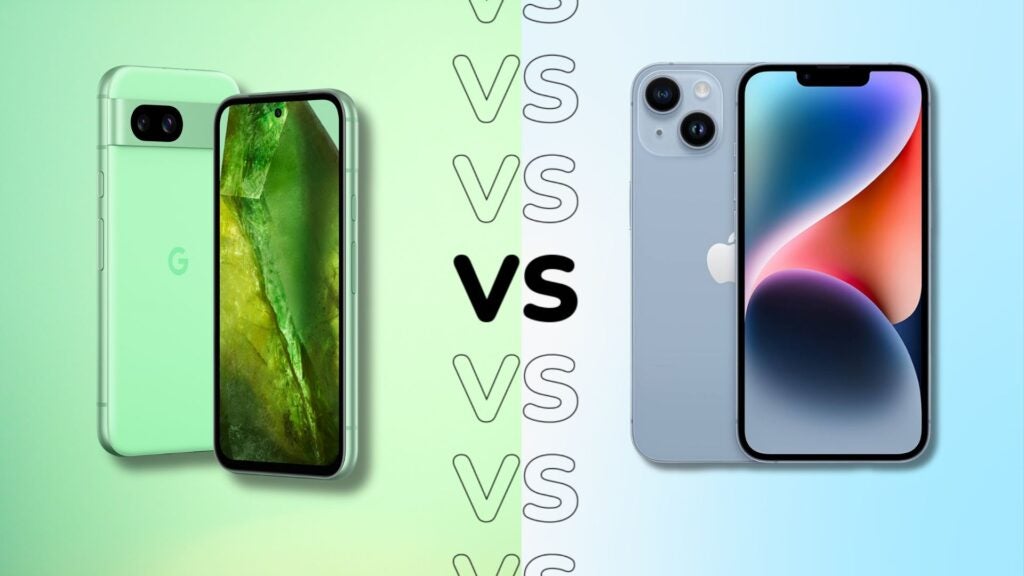
![]()
The Google Pixel 8a is the latest mid-range smartphone to hit the market – but how does it compare to the popular iPhone 14?
While it might seem odd to compare a mid-range phone and a flagship phone, the iPhone 14 has dropped in price dramatically since it first came to market in 2022, making the choice between whether to buy a Pixel 8a or an iPhone 14 a very real one for consumers.
With that said, here are five key differences between the Google Pixel 8a and iPhone 14 to help you buy the best smartphone for your specific needs.
The iPhone 14 has a higher-quality build
While design preferences are largely subjective, it’s hard to argue that the iPhone 14 isn’t the better-built smartphone of the two – largely because it was once a premium phone before dropping down into mid-range territory with the release of subsequent iPhones.
That means that all the staples of a high-end smartphone, including the use of glass and aluminium in place of the aluminium and plastic build of the Google Pixel 8a, but it goes further than that.
The iPhone 14 also offers better IP68 dust and water resistance than the IP67 of the Pixel 8a, and it also uses Gorilla Glass and Apple’s own Ceramic Shield tech to protect the rear and front glass respectively. The Pixel 8a does have its own display protection in the form of Gorilla Glass 3, but that’s fairly long in the tooth in 2024.
The iPhone 14 is also thinner and lighter at 7.8mm and 172g respectively, compared to the 8.9mm and 188g on offer from the Pixel 8a.
That’s not to say that the Pixel 8a isn’t a good-looking phone; it has rounded edges, the same matte finish as the Pixel 8 Pro and the infamous camera bar doesn’t protrude quite as far as the flagship variants either. It’s just not quite up to the task of taking on a flagship-level iPhone.
Image Credit (Trusted Reviews)
The Google Pixel 8a has higher-res cameras
There’s more to a good quality camera than megapixel count, but with pixel-binning tech utilised on most high-res smartphone sensors, it certainly helps. That’s what Google hopes with the Pixel 8a anyway, with a higher-res camera offering than the competing iPhone 14.
More specifically, the Pixel 8a sports a main 64MP camera with an f/1.9 aperture and OIS, backed up by a 13MP f/2.2 120-degree ultrawide camera.
The iPhone 14, on the other hand, has dual 12MP main and ultrawide lenses, though with a wider f/1.5 aperture on the main camera, it could perform better than the Pixel 8a specifically in low-light conditions.
However, where the Pixel 8a – and Pixels in general – excel is in the AI department, with AI-powered photo modes like Night Shot and Super Res Zoom delivering images of a higher quality than its mid-range price tag suggests. There’s also a bunch of AI-powered photo editing tools that you won’t find on the competing iPhone.
However, we did find that the iPhone 14 took exceptional shots when we reviewed it back at release in 2022, so we’ll have to do some side-by-side testing to determine which is actually the better camera of the two.
The iPhone 14 is more powerful than the Pixel 8a
The Google Pixel 8a sports the same Tensor G3 chipset as the flagship Pixel 8 and Pixel 8 Pro – making it all the more surprising that the two-year-old iPhone 14 and its A15 Bionic chipset manages to beat the G3 in terms of sheer power output in our early benchmark testing.
Admittedly, Google has never focused on making the Tensor chipset the most powerful around. Instead, it focuses more on AI capabilities, helping power some of the cool camera and photo tech mentioned earlier as well as other AI functionality baked into the phone’s operating system.
Still, that means that when it comes to gaming or any other chip-heavy tasks, the iPhone 14 will be the more capable option.
Image Credit (Trusted Reviews)
The Google Pixel 8a has a faster screen
As it was once a flagship-level phone, the iPhone 14’s 6.1-inch OLED screen comes packed with all kinds of premium tech simply not offered by the mid-range Pixel 8a including support for HDR10 and Dolby Vision, but Google isn’t out of the fight just yet.
You see, the Pixel’s competing 6.1-inch OLED screen has something that the iPhone 14 doesn’t; a super smooth 120Hz refresh rate. While that’s common among even budget Android phones, it’s a feature that remains exclusive to the Pro and Pro Max models of iPhone. That means that the Pixel 8a looks and feels smoother and more responsive in everyday use, and that translates to a more frame-packed gameplay experience too.
The Pixel 8a is also brighter than the iPhone 14, with a maximum brightness of 2000nits compared to 1200nits, and although it’s a slightly lower resolution screen, the Pixel 8a’s always-on screen tech makes it a worthy trade-off.
The iPhone 14 is slightly more expensive
While the iPhone 14 was a flagship smartphone that cost £849 at release in 2022, the price has dropped significantly in the two years since. At the time of writing, you can pick up an iPhone 14 for just £599 at Amazon.
Meanwhile, the Google Pixel 8a will set you back £499, and it’s available to buy right now following its announcement earlier in May.







